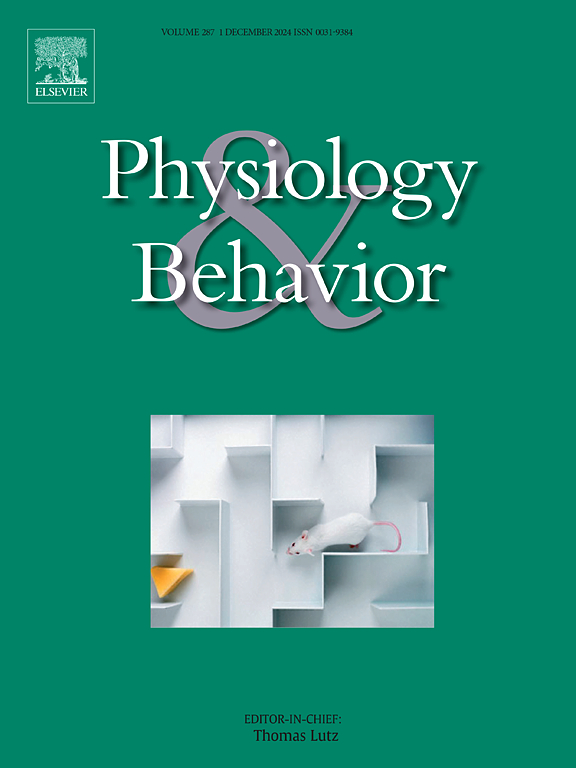Orexin-A and BDNF in the hippocampus of middle-aged rats: beneficial effects of integrating voluntary physical activity with intermittent fasting
IF 2.5
3区 医学
Q2 BEHAVIORAL SCIENCES
引用次数: 0
Abstract
Aging is associated with cognitive decline, reduced hippocampal function, and decreased levels of brain-derived neurotrophic factor (BDNF) and orexin A —key regulators of neuroplasticity and energy balance. This study examined the chronic effects of intermittent fasting (IF), both alone and in combination with voluntary physical activity, on hippocampal orexin A, orexin receptor 1, and BDNF levels in middle-aged male Wistar rats. Over eight weeks, rats were divided into control (Con), IF, and IF with voluntary wheel running (IF+VA) groups. Behavioral assessments (open field, rotarod), biochemical analyses (Western blot, ELISA), and hippocampal weight measurements were conducted. IF significantly elevated hippocampal orexin A and BDNF levels compared to Con, with the IF+VA showing the most pronounced increases. Interestingly, orexin receptor 1 expression decreased in the IF+VA group, potentially indicating a negative feedback response or an alternative pathway. Moreover, a strong positive correlation between orexin A and BDNF levels suggests a possible causal relationship. The IF+VA group also showed improved motor learning and coordination as well as increased hippocampal/brain weight ratio. These findings indicate that combined fasting and voluntary physical activity may mitigate age-related cognitive and functional decline beyond IF alone by modulating orexinergic and BDNF signaling pathways, offering a potential role of the orexinergic system in the hippocampus.
中年大鼠海马中的食欲素a和BDNF:自愿体育活动与间歇性禁食相结合的有益作用
衰老与认知能力下降、海马功能下降、脑源性神经营养因子(BDNF)和食欲素A水平下降有关,这是神经可塑性和能量平衡的关键调节因子。本研究检测了间歇性禁食(IF)对中年雄性Wistar大鼠海马食欲素A、食欲素受体1和BDNF水平的慢性影响,无论是单独还是结合自愿体育活动。在8周的时间里,大鼠被分为对照组(Con)、IF组和IF+VA组。进行行为评估(open field, rottarod),生化分析(Western blot, ELISA)和海马体重测量。与对照组相比,IF显著提高了海马食欲素A和BDNF水平,其中IF+VA的升高最为明显。有趣的是,在IF+VA组中,食欲素受体1的表达下降,可能表明存在负反馈反应或其他途径。此外,食欲素a和BDNF水平之间存在强烈的正相关关系,表明两者之间可能存在因果关系。IF+VA组也表现出运动学习和协调能力的改善,以及海马/脑重量比的增加。这些发现表明,结合禁食和自愿体育活动可以通过调节食欲能和BDNF信号通路来减轻与年龄相关的认知和功能下降,而不仅仅是IF,这提供了食欲能系统在海马中的潜在作用。
本文章由计算机程序翻译,如有差异,请以英文原文为准。
求助全文
约1分钟内获得全文
求助全文
来源期刊

Physiology & Behavior
医学-行为科学
CiteScore
5.70
自引率
3.40%
发文量
274
审稿时长
47 days
期刊介绍:
Physiology & Behavior is aimed at the causal physiological mechanisms of behavior and its modulation by environmental factors. The journal invites original reports in the broad area of behavioral and cognitive neuroscience, in which at least one variable is physiological and the primary emphasis and theoretical context are behavioral. The range of subjects includes behavioral neuroendocrinology, psychoneuroimmunology, learning and memory, ingestion, social behavior, and studies related to the mechanisms of psychopathology. Contemporary reviews and theoretical articles are welcomed and the Editors invite such proposals from interested authors.
 求助内容:
求助内容: 应助结果提醒方式:
应助结果提醒方式:


